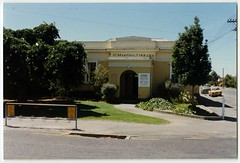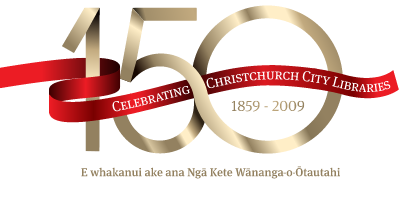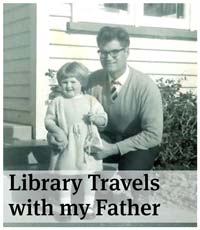St. Martins Public Library, 1927-2003
“An integral part of the fabric of the St Martins area”. Lois Tabb’s description of the St. Martins Public Library in 2000 still explains the popularity of this community run library in 2009, 82 years after it first opened.
Early Days
The St Martins Public Library was founded by a local bricklayer, trade unionist and stalwart of the community, John Edward Jones who had arrived in Christchurch in 1911. He led a local group from St Martins to ask the Council for a community hall in the district in 1923. The Council declined the hall, but agreed to build a library if a suitable site could be found. Jones’ group soon became a Residents’ Association after an initial meeting in a local packing shed in 1924. When a site was located on the corner of Wilsons and Wades Roads, several residents each put up 100 pounds, raising 1000 pounds as a deposit for the purchase of 3 sections. The new library building cost 1100 pounds, measured 35 feet by 20 feet enough room for about 4000 books.
 St. Martins Library was officially opened 5 February 1927 by the first Labour mayor of Christchurch, John Kendrick Archer (1865-1949), with 161 subscribers and 739 books. The annual subscription was set at 6 shillings per annum. The first committee was equally divided between men and women members, but all the officeholders were men, with Jones elected as president and a local electrician, Frederick Holland, as secretary. Only male volunteers acted as librarians during opening hours; the women were responsible for repairing books.
St. Martins Library was officially opened 5 February 1927 by the first Labour mayor of Christchurch, John Kendrick Archer (1865-1949), with 161 subscribers and 739 books. The annual subscription was set at 6 shillings per annum. The first committee was equally divided between men and women members, but all the officeholders were men, with Jones elected as president and a local electrician, Frederick Holland, as secretary. Only male volunteers acted as librarians during opening hours; the women were responsible for repairing books.
Committee members canvassed the neighbourhood for both subscribers and donations, and by the end of the year, there were 273 members on the books, and 1851 books on the shelves. Much of the first year was spent in fund raising, as the cost of all the floor coverings, new fixtures, chimney and fireplace, and other furnishings were met by the committee. Euchre evenings and concerts were among the successful events held. At the same time, Holland began cataloguing the book collection, with assistance from two members of the voluntary committee at Addington Library, Edward Parlane (1874-1959), later a city councillor, and Thomas Henry Tilleyshort.
Depression Years and After
Despite the Depression, the library continued to grow through the 1930s, with between 500 and 600 subscribers and a rapidly expanding book collection of some 8000 volumes, about 20% being non-fiction. By 1933, the committee began lobbying the Council for additional space. The Council was unable to help due to a lack of funds. During the Depression years library subsidies were cut with St. Martins’ subsidy was reduced from 80 to 64 pounds. By 1935 expansion became possible and an additional wing was added to the library, at a cost of 560 pounds. It was divided from the first room by a wooden partition so that it could also be used as a community hall.
The library continued to be well patronised over the next decade, even although another community run library was opened in Opawa in 1936, only half a mile from St. Martins. Nonetheless, by 1948, there were 760 St. Martin’s library members, and the book collection numbered over 20,000 volumes. Five of the original committee were still actively involved in the library, including Jones with many volunteers continuing their work up until their death or late in their retirement. Sarah Emma Holland retired in 1960 at the age of 75, having served on the committee from its beginnings.
St. Martin’s library members and volunteers remained fiercely loyal to the institution over the next 50 years, and the library continued to be well used. As elsewhere within the community run library network, a free children’s library service was opened in the 1950s, and by 1977, over 1000 children were enrolled. This service was funded by Council rates and was served by Canterbury Public Library’s children’s librarian, Mrs Helen Constable.
Effect of the New South Library
Despite extensive renovations to the library building in 1977 ten years later, the Council’s cultural committee declared the building to be an earthquake risk and not suitable for expansion. In June 1988, the cultural committee listed a new library at St. Martins as a top priority. Local government amalgamation the following year put all library development projects on hold until 1997. In that year further refurbishment at St. Martins was carried out, jointly funded the committee and Canterbury Public Library.
Over the next few years, the Council began to consider the future development of all the libraries in south Christchurch. The decision to build a major new community library in lower Cashmere (Christchurch South Library) meant that remaining community run libraries in the district were considered no longer necessary. This view was strongly contested by both the volunteers and subscribers. The St. Martins president in 2000, Edyth Coursey, argued that the library still had about 1000 subscribers, mainly children and senior citizens who would find transport to another library difficult.
In the end a compromise was reached. The St Martins children’s library bookstock and librarian, who had been operating as part of the public library network for some years, relocated to the new South Library.
St. Martins Library continued to operate as a fiction and magazine collection for adult borrowers. A committee of volunteers operates the library with support from the Christchurch City Council.
Earthquake damage leads to demolition
The library building was damaged in the earthquake of September 4, 2011 and was closed to the public. Further damage occurred in the 22 February, 2011 and June 13, 2011 earthquakes and the demolition of the rear section was begun on July 15, 2011.A decision on the future of the remaining building is still to be made.
Related:
- St. Martins Public Library, 1927-1948
A digitised copy of a short history of the St. Martins Public Library outlining the efforts to set up and finance the library.



